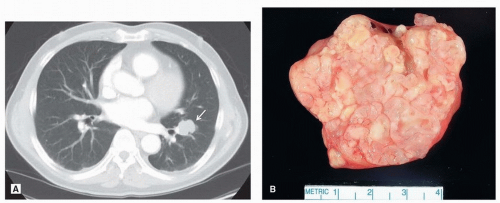Hamartoma and Chondroma
Marie-Christine Aubry, M.D.
Fabio R. Tavora, M.D., Ph.D.
General
Hamartoma and chondroma are neoplasms with overlapping histologic features, mainly the presence of cartilage. However, they are distinct and should be separated from each other because of the potential clinical implication of a diagnosis of chondroma. Hamartomas are the most common benign tumor of the lung and are composed of various soft tissue components beyond cartilage, including adipose tissue and smooth muscle, with entrapped reactive bronchiolar epithelium. Hamartomas occur most commonly in older men (reported ratio of ˜2:1 and mean age of 65 years).1 They are typically asymptomatic solitary lesions found during investigation of various medical or surgical conditions or incidentally found during surgical resection of lung cancers.1,2 In contrast, chondromas are rare benign cartilaginous neoplasms, typically presenting in patients with Carney triad, a rare disorder that includes gastrointestinal stromal tumors, extra-adrenal paragangliomas, and other neoplasms and thus affecting predominantly young women with incidental multiple nodules.3 Chondromas may also be sporadic, occurring in older men as incidental solitary nodules.3
Radiologic Findings
Hamartomas are most commonly peripheral lesions (>90%) but can present as endobronchial lesions. They are distributed evenly in the right and left lung and show no lobe predilection. Hamartomas form well-demarcated lobulated nodules or masses (Fig. 69.1). Imaging by CT scan is often considered diagnostic if popcornlike calcifications and/or fat density is identified.4 However, these findings are not always present and have also been described in chondromas. Rare cases of PET-positive hamartomas have been reported.5
Gross Findings
Hamartomas vary in size with an average size of 1.5 to 2 cm, but tumors over 25 cm have been described and are often referred to as giant hamartoma.1,2,6 They are well-circumscribed, lobulated, firm lesions that typically shell out from the surrounding lung1 (Fig. 69.1).
Chondromas range in size between 1 and 9 cm and have an average size of 3 cm. They are described as well circumscribed and bosselated with a gritty cut surface of white color (Fig. 69.2). They are occasionally cystic or hemorrhagic.3
Stay updated, free articles. Join our Telegram channel

Full access? Get Clinical Tree



